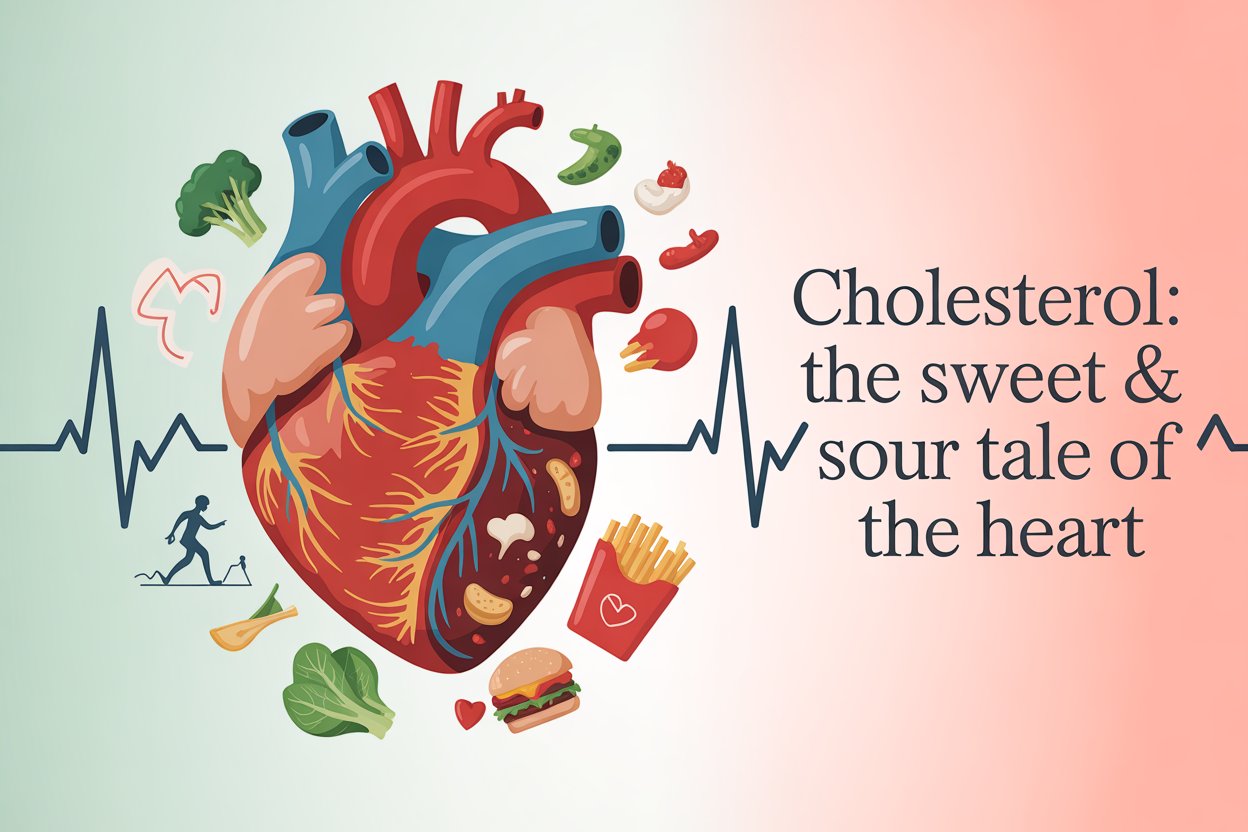Table of Contents
Overview: “A Journey Inside Heartville”
Once upon a time, in a magical city called Heartville—which means the city of our heart—lived three little travelers named HDL, LDL, and Triggy (Triglyceride). Let me tell you about their adventures!
HDL – This one was the Helpful Delivery Lipid, always cheerful, hardworking, and everyone’s favorite.
LDL – The Lazy Delivery Lipid, obsessed with junk food and always causing traffic jams (in our body’s arteries).
Triggy (Triglyceride) – A bubbly bundle of energy, always full of power… and double the snacks!
Every day, HDL cleaned up the roads (arteries), picking up the mess left behind by LDL and Triggy. But when LDL started dropping too much fat and Triggy brought an overload of fried foods, the roads got badly clogged.
The Heart—the king of Heartville—became tired and weak because of all this mess. Problems began to grow.
But then came the leader of Heartville—yes, I mean you!
You made some healthy lifestyle changes: started eating more fruits, exercising regularly, and said goodbye to junk food.
And guess what happened?
HDL became happy again, the roads (arteries) got cleared, and the Heart, the king of Heartville, danced with joy once more! Everything started getting better. Your body began working properly again, and you were saved from serious issues like heart attack, atherosclerosis, chest pain, angina, and more!
What is Cholesterol? – Explained in Easy Words
Cholesterol is a fatty substance found in our blood. It is essential for the body, but if its level becomes too high, it can cause health problems.
What does cholesterol do?
1- It helps in building cells (helps indirectly)
2- It makes hormones (not directly but provide a suitable environment).
3- It helps produce Vitamin D
So, we actually can’t survive without cholesterol!
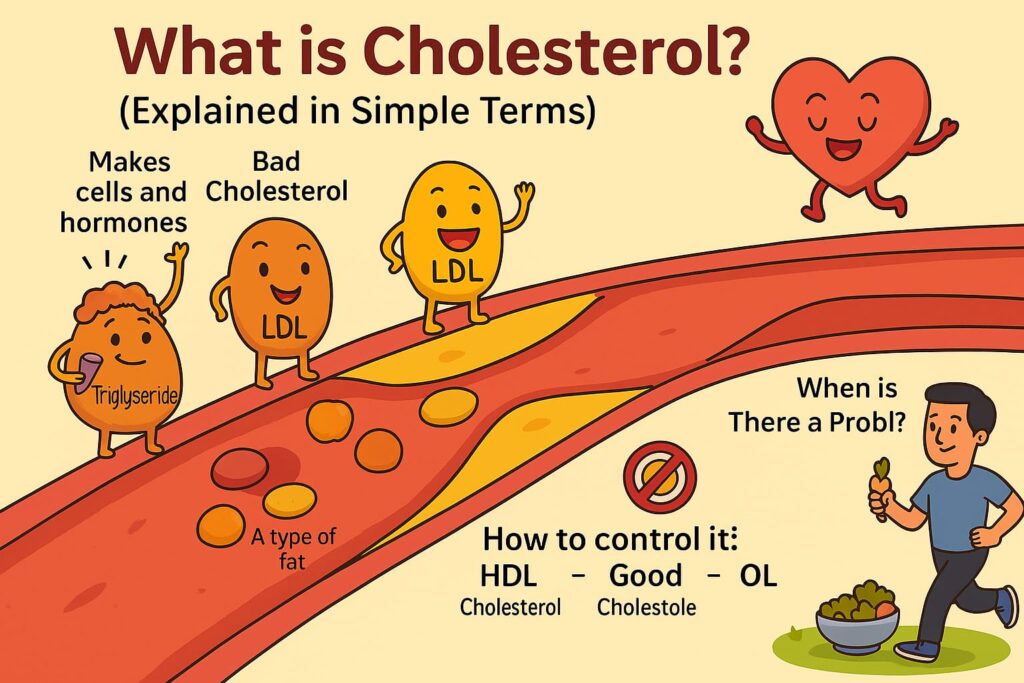
Two Main Types of Cholesterol
1-HDL (High-Density Lipoprotein) :–
The HDL also Known as “Good Cholesterol”. It transport cholesterol from arteries to liver for removal and it removes extra cholesterol from the body and keeps arteries clean. The normal range of HDL is >60mg/dL consider as good and if it is <40mg/dL consider as risky. Exercise, eat healthy fat like olive oil and quitting smoking lead to increase HDL.
2-LDL (Low-Density Lipoprotein) :–
Low density lipoprotein also Known as “Bad Cholesterol”. It builds up in the arteries, result in plaque formation so in this way it leads to atherosclerosis (narrowing of arteries) increasing the risk of heart attack or stroke. The ideal range of LDL is <100mg/dL and >160mg/dL consider it as high risk. It is caused by junk food, lack of exercise, saturated fat (butter, ghee cheese, red meat. etc.) and trans fat (bakery items, fried snacks or processed food).
What are Triglycerides?
Triglycerides stored in fat cells used for energy between meals. Triglyceride are another type of fat that increases when we eat too much oily or sugary food, alcohol and lack of exercise. High levels can also raise heart disease risk. The normal range of triglyceride is <150mg/dL and high risk at >200mg/dL.
When does it become a problem?
When LDL and Triglycerides increase, and HDL decreases, the blood can’t flow properly to the heart, and the heart becomes weaker.
How to control cholesterol?
1- Eat a healthy diet (fruits, veggies, whole grains).
| Fruits & Veggies: | High in fiber, which helps remove extra cholesterol from the body. |
| Whole Grains: | Like oats and brown rice lower bad cholesterol (LDL). |
| Low in Bad(LDL) Fats: | These foods don’t raise cholesterol like junk food does. |
| Rich in Antioxidants: | Protect arteries from cholesterol damage. |
2- Do regular exercise. It will help to prevent the formation of fats in the arteries and veins.
3- Avoid junk food because it contains trans fat and saturated fat that can lead to an increase in the cholesterol level.
4- Stay away from smoking and alcohol because they damage your blood vessels and mess up your cholesterol level.
5- Get blood tests (lipid profile test) as advised by your doctor, it will help you to know your cholesterol level.
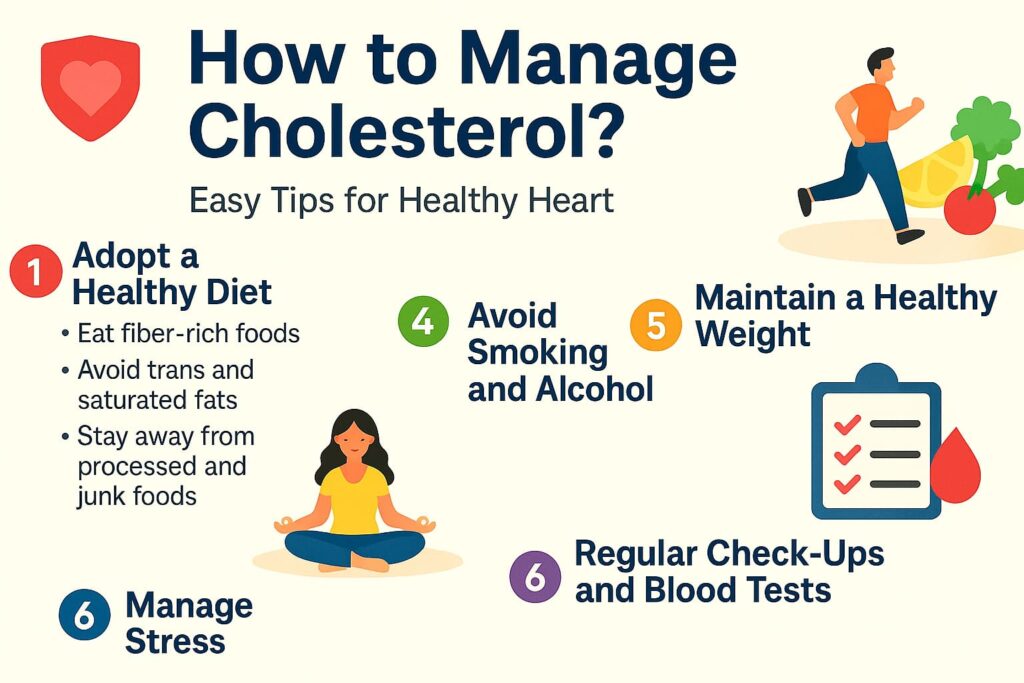
Causes of Cholesterol
1. Unhealthy Diet
Eating too much oil, ghee, butter, cheese, red meat, and junk food (like burgers and pizza). Fried and processed foods increase cholesterol.
2. Lack of Physical Activity
People who sit all day and don’t exercise taking unhealthy foods often have rising levels of LDL (bad cholesterol).
3. Smoking and Alcohol Consumption
Smoking lowers HDL (good cholesterol) and damages wall of arteries and making cholesterol easily stick into it. Too much alcohol harms the liver and raises fat levels.
4. Genetics or Family History
Familial hypercholesterolemia (inherited) causes very high LDL even slim or healthy people. If someone in your family has high cholesterol or heart disease, your risk increases too. Regular screening is important.
5. Obesity (Overweight)
Extra body weight increases LDL and triglycerides and it also lowers HDL.
6. Stress
Long-term stress disrupts hormones, which can affect cholesterol levels. It triggers unhealthy eating lead to raise bad cholesterol indirectly.
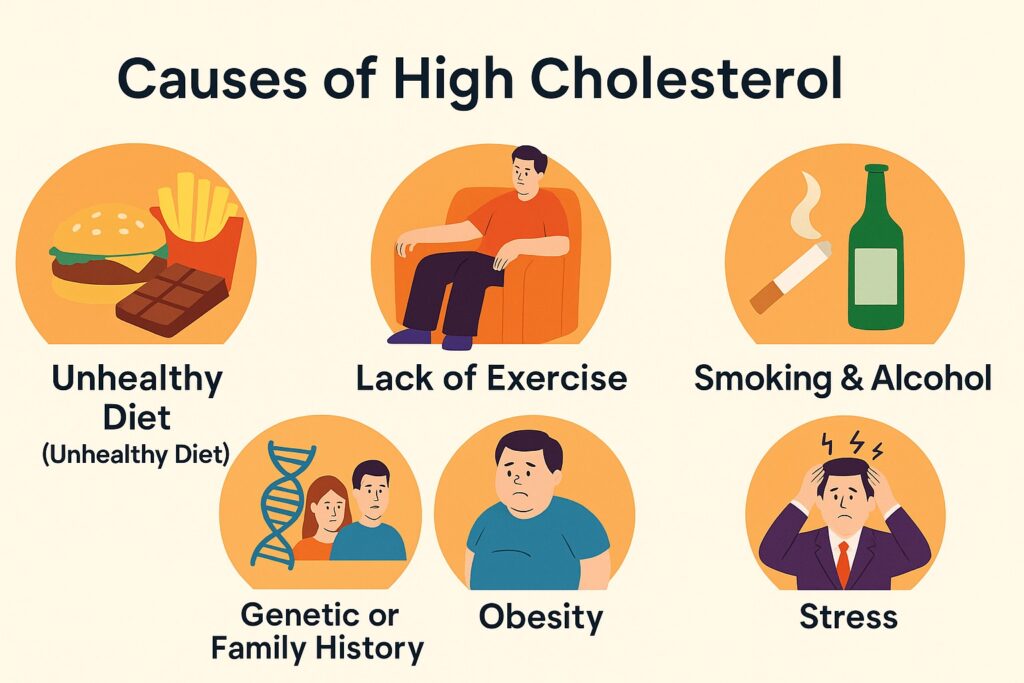
Health Risks of High Cholesterol
1. Heart Attack
When cholesterol builds up in arteries (forms plaque), it can block blood flow. This blockage stops oxygen from reaching the heart, causing a heart attack.
2. Stroke
If brain arteries get blocked due to cholesterol, blood flow to the brain stops. This can lead to a stroke, which may cause paralysis or even death.
3. Atherosclerosis
A condition where arteries become narrow and hard due to cholesterol plaque. It blocks smooth blood flow and puts extra pressure on the heart.
4. Angina (Chest Pain)
When the heart doesn’t get enough blood, it causes chest pain. This is called angina, an early sign of heart disease.
5. Peripheral Artery Disease (PAD)
Cholesterol blocks blood flow in arms or legs. This causes pain, numbness, and slow wound healing.
6. High Blood Pressure (Hypertension)
Blocked arteries make the heart work harder to pump blood, leading to high BP.
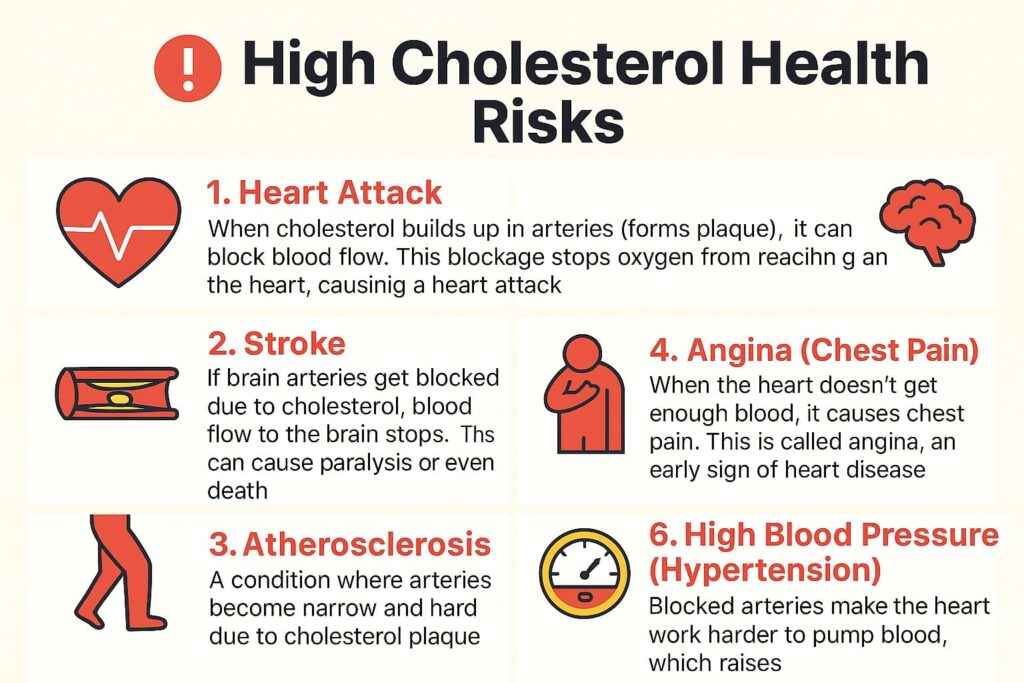
When to Consider Medication for High Cholesterol
While healthy eating and exercise are the first steps to controlling cholesterol, sometimes medication is necessary — especially if your risk of heart disease is high or lifestyle changes aren’t enough.
You may need medication if:
- Your LDL cholesterol is very high:– If your LDL (“bad” cholesterol) is 160 mg/dL or above, especially with other health risks.
- You already have heart disease:- Previous heart attack, stroke, angina, or blocked arteries — medication is often essential.
- You have diabetes or high blood pressure:-These conditions increase your risk of heart problems — so cholesterol-lowering drugs may be prescribed early.
- You have a family history of high cholesterol:- If high cholesterol runs in your family, doctors may recommend preventive medication even if you’re young.
- Your triglycerides are too high:– If triglyceride levels go above 200 mg/dL, medicine may be used to lower your risk of heart disease or pancreatitis.
What medications are used?
- Statins (most common) – Atorvastatin, Rosuvastatin
- Fibrates – especially for high triglycerides
- Niacin, Ezetimibe – in special cases
How and When to Get Tested
Get a lipid profile test (HDL, LDL, Triglycerides, Total cholesterol). Every 4–6 years after age 20, or more often if at high risk. Fasting 9–12 hours before test is usually required. Available at pathology labs, clinics, and hospitals.
Frequently Asked Questions (FAQs)
Q: What is cholesterol?
A: Cholesterol is a fatty substance in your blood needed for body functions, but too much can be harmful.
Q: What is the difference between HDL and LDL?
A: HDL is good cholesterol; it removes bad cholesterol. LDL is bad cholesterol; it can clog arteries.
Q: What are the symptoms of high cholesterol?
A: Usually there are no symptoms. It is detected by a blood test.
Q: What causes high cholesterol?
A: Unhealthy food, inactivity, smoking, alcohol, stress, and genetics.
Q: How can I control cholesterol?
A: Healthy diet, exercise, quitting smoking, and regular testing.
Q: When should I take medication?
A: When lifestyle changes aren’t enough or if you have heart disease or high-risk profile.
Q: How and when should I get tested?
A: Get a lipid profile test after 20 years of age every 4–6 years or more frequently if at risk.
